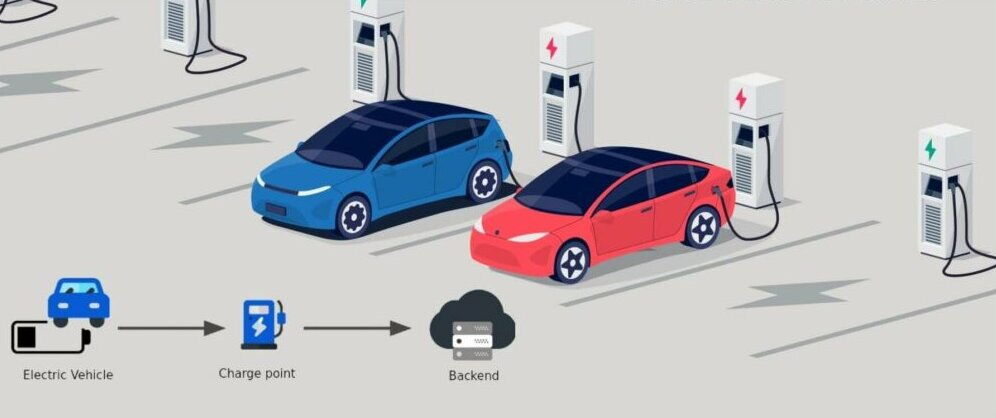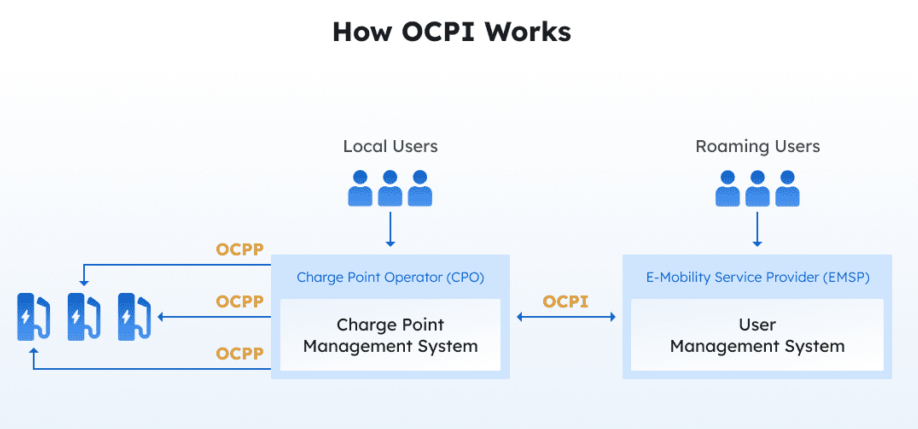The electric vehicle (EV) industry is undergoing a transformative shift as global efforts to reduce carbon emissions and embrace sustainable transportation accelerate. With more consumers and businesses adopting EVs, the demand for reliable, scalable, and interoperable charging infrastructure has become more crucial than ever. Two critical protocols that facilitate the seamless operation of EV charging networks are the Open Charge Point Interface (OCPI) and the Open Charge Point Protocol (OCPP). While both serve essential roles in eMobility, they focus on different aspects of the EV charging ecosystem.
This article explores the key differences between OCPI and OCPP, their functionalities, and how they work together to create an efficient and user-friendly EV charging network.

The Open Charge Point Interface (OCPI) is a widely adopted protocol that enables seamless communication and data exchange between Charge Point Operators (CPOs) and e-Mobility Service Providers (EMSPs). The primary purpose of OCPI is to enhance interoperability across different EV charging networks, ensuring that EV drivers can charge their vehicles effortlessly, regardless of the network they use.
To understand how OCPI functions, it’s important to define its primary stakeholders:
1. Charge Point Operators (CPOs): CPOs are responsible for managing and maintaining EV charging stations, ensuring their availability, reliability, and overall operation. They either own the charging infrastructure directly or operate it on behalf of other businesses.
2. e-Mobility Service Providers (EMSPs): EMSPs offer charging services to EV drivers via mobile apps, online platforms, or other digital interfaces. They provide essential services such as station availability, pricing, navigation, and payment processing. Some EMSPs may also act as CPOs, integrating both roles into their operations.
OCPI plays a crucial role in streamlining the EV charging experience. Some of its core functionalities include:
Roaming Agreements: With OCPI, EV drivers can seamlessly access multiple charging networks without needing separate accounts or subscriptions. This ensures cross-network compatibility and enhances convenience.
Real-Time Data Sharing: OCPI facilitates real-time exchange of information about charging station availability, pricing, and operational status between CPOs and EMSPs.
Transaction Processing: The protocol enables secure and efficient payment mechanisms, ensuring that drivers can pay for charging sessions effortlessly.
Remote Access to Charging Networks: By using OCPI, different networks can communicate and collaborate, expanding accessibility for EV users and increasing utilization rates for charging stations.
By standardizing how CPOs and EMSPs interact, OCPI significantly improves the user experience and business efficiency in EV charging. It allows EV drivers to access a wide range of charging stations without encountering compatibility issues, thereby supporting the widespread adoption of electric mobility.

The Open Charge Point Protocol (OCPP) is an open-source communication standard that enables interoperability between EV charging stations (hardware) and charging management systems (software). Unlike OCPI, which focuses on CPO-to-EMSP communication, OCPP ensures that charging stations can connect and communicate seamlessly with a variety of backend systems.

OCPP provides several advantages that make it an essential standard for EV charging infrastructure:
Hardware-Software Compatibility: OCPP allows any OCPP-compliant charging station to operate with any OCPP-compliant management system, preventing vendor lock-in and increasing flexibility for operators.
Remote Monitoring and Management: Charging stations can be managed remotely, allowing operators to diagnose issues, perform firmware updates, and optimize performance without needing on-site intervention.
Scalability: OCPP is designed to support networks of all sizes, from local charging hubs to nationwide or even global charging networks.
Customization and Adaptability: Operators can tailor OCPP settings to meet their specific operational requirements, ensuring efficiency and future-proofing their infrastructure.
By enabling interoperability between hardware and software, OCPP helps prevent technological fragmentation in the EV charging industry. Operators can freely choose from various vendors without worrying about compatibility issues, fostering competition and innovation in the market.
|
Feature |
OCPI |
OCPP |
|
Primary Purpose |
Enables communication between CPOs and EMSPs |
Enables communication between charging stations and management systems |
|
Scope |
Focuses on interoperability between charging networks |
Focuses on standardizing communication between hardware and software |
|
Stakeholders |
CPOs, EMSPs |
Charging station manufacturers, network operators |
|
Main Functions |
Roaming, real-time data sharing, transaction processing |
Remote monitoring, firmware updates, diagnostics |
|
Interoperability Focus |
Allows EV drivers to charge across different networks |
Ensures charging stations work with different backend systems |
Both protocols play complementary roles, ensuring a seamless experience for both charging operators and EV drivers.
Even though OCPI and OCPP serve different functions, they work in tandem to create a well-integrated and efficient EV charging ecosystem. Their combined benefits include:
OCPP ensures that charging stations can communicate with central management systems, allowing operators to monitor performance and make adjustments as needed.
OCPI enables real-time station updates, seamless roaming, and integrated payment processing, making EV charging more convenient for users.
While OCPP transmits data between charging hardware and backend software, OCPI ensures this data is shared effectively with EMSPs, keeping EV drivers informed.
The combination of OCPI and OCPP allows the EV industry to develop scalable and adaptable charging networks that can grow with increasing demand.
Together, these protocols create a robust, user-friendly, and highly efficient charging infrastructure that supports the expansion of electric mobility worldwide.
As the EV industry continues its rapid expansion, the importance of standardized communication protocols like OCPI and OCPP cannot be overstated. While OCPI enhances interoperability between charging networks and service providers, OCPP ensures seamless interaction between charging stations and management software.
Understanding the roles of these protocols is critical for CPOs, EMSPs, policymakers, and businesses looking to establish or expand EV charging infrastructure. By leveraging both OCPI and OCPP, the industry can create flexible, scalable, and user-friendly charging networks that accelerate the global transition to sustainable transportation.
With OCPI and OCPP working together, the future of EV charging is more accessible, efficient, and interconnected—paving the way for a cleaner and greener tomorrow.